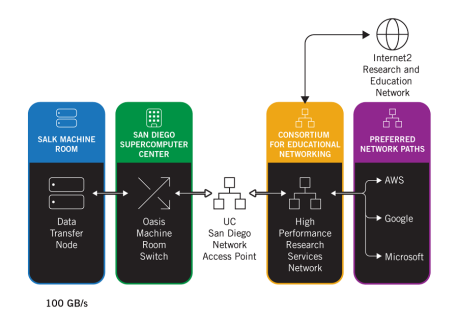
August 27, 2024
The Salk Institute’s research in cancer, healthy aging, immunobiology, neuroscience, and other critical areas—which increasingly relies on multi-institution collaboration and data-intensive methods such as machine learning and artificial intelligence—requires leading-edge networking infrastructure
LA JOLLA—The Salk Institute has launched the Salk Science Network (SciNET), a new state-of-the-art, high-speed network that enhances scientific data transfer between research collaborators. This offering is the latest advancement enabled by Salk’s Biocomputation Initiative, which aims to provide the funding, technology, and expertise required to address the challenges posed by increasingly data-intensive research in biological sciences, such as machine learning and artificial intelligence.

“The Salk Science Network is not just a technological upgrade—it’s a bridge connecting our scientists with global research collaborators,” says Salk Chief Information Officer Jerry Sheehan. “This high-speed network ensures that our data transfers are as seamless and swift as possible, facilitating deeper and more productive scientific partnerships.”
The new network leverages the US Department of Energy’s Science DMZ architecture to create a high-speed data expressway, ensuring that significant data transfers occur quickly and reliably. The Science DMZ is a specialized architecture that isolates scientific data traffic from everyday internet use, such as emails, web browsing, and video conferencing. This ensures that substantial data transfers, such as single-cell genomic pipelines or high-resolution imaging data, are completed swiftly and securely. The network incorporates advanced security measures to protect sensitive research data while allowing seamless access to remote computing resources and collaborative platforms.
Here is one example of how SciNet will enable high-impact research: In 2022, Salk Professor Joseph Ecker and Research Professor Margarita Behrens received the largest grant in the Institute’s history—$77 million from the National Institutes of Health—to establish the Center for Multiomic Human Brain Cell Atlas. The project aims to describe the cells that make up the human brain in unprecedented molecular detail, classify brain cells into more precise subtypes, and pinpoint the location of each cell in the brain. What’s more, the team will track how these features change over the course of a human life span.
This is an exciting opportunity to understand better how the brain operates in both health and disease, Ecker says. However, he estimates that for this one project, his lab will generate 20 petabytes of raw data—the equivalent of approximately 4.3 billion high-resolution photos.
“The launch of the Salk Science Network marks a transformative moment for our research,” Ecker says. “As we embark on ambitious projects like the Multiomic Human Brain Cell Atlas, SciNet ensures that we can seamlessly transfer and analyze enormous datasets. This advanced network is more than just a tool; it’s an essential platform that empowers our scientists to collaborate globally and unlock new insights into the brain’s molecular architecture.”
The Salk Science Network connection operates at 100 gigabytes per second, providing an off-ramp into the San Diego Supercomputer Center’s data center before entering the Consortium for Educational Networking in California’s High-Performance Research service. This setup offers fast, direct access to regional, national, and international research networks, including Internet2, and direct access to commercial cloud providers such as AWS, Google, and Azure.
“Digital data is the lifeblood of modern biological research, and the ability to efficiently transfer and analyze large volumes of data is critical for transformational science,” says Salk Chief Science Officer Jan Karlseder, professor and holder of the Donald and Darlene Shiley Chair. “The Salk Science Network will facilitate the rapid transfer of vast datasets, helping us transform raw data into groundbreaking insights.”
For more information, please visit:
Office of Communications
Tel: (858) 453-4100
press@salk.edu
Unlocking the secrets of life itself is the driving force behind the Salk Institute. Our team of world-class, award-winning scientists pushes the boundaries of knowledge in areas such as neuroscience, cancer research, aging, immunobiology, plant biology, computational biology and more. Founded by Jonas Salk, developer of the first safe and effective polio vaccine, the Institute is an independent, nonprofit research organization and architectural landmark: small by choice, intimate by nature, and fearless in the face of any challenge.